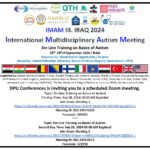
October 28, 2018 – Damascus – SANA
A recent European study has added new evidence to the genetic link to autism, showing that the correlation is comparable to that found in schizophrenia, attention deficit hyperactivity disorder (ADHD), and bipolar disorder — and even stronger than in cases of depression and obsessive-compulsive disorder (OCD).
The study, which analyzed data from approximately 4.5 million individuals in Sweden, coincided with an American study that identified 102 genes associated with autism — a figure twice as high as previously known. Researchers considered it a breakthrough in distinguishing autism from intellectual disability and developmental delay.
According to psychological consultant Dr. Osama Abdullah, autism is a disorder that affects a child’s developmental state and is referred to as a “spectrum” due to its wide range of behavioral, social, educational, and medical manifestations. It can be accompanied by sensory, auditory, or visual impairments, as well as speech difficulties.
In a statement to SANA Health on the sidelines of a lecture in Damascus, Dr. Abdullah explained that autism is behaviorally diagnosed only when three core criteria are present: abnormalities in social relationships and development, failure to establish natural communication with others, and a tendency toward limited and repetitive activities instead of flexible and creative ones.
He noted that autism manifests in numerous symptoms, with at least six needed to confirm a diagnosis. These include impaired ability to express emotions, difficulty with social interaction, poor non-verbal communication such as lack of eye contact or facial expressions, inability to form age-appropriate peer relationships, and a lack of interest in shared recreational or goal-oriented activities.
Other signs include delayed or absent speech development, repetitive or stereotyped use of language, absence of imaginative play or social imitation, and restriction to a narrow set of stereotypical behaviors.
At early developmental stages, autism may be identified through signs such as excessive passivity, weak crying, rigidity or hyperactivity, resistance to feeding, lack of response to sounds, aversion to parental touch, absence of direct eye contact, and delayed motor skills.
Dr. Abdullah also highlighted associated behaviors and conditions commonly found in individuals with autism, such as anxiety, anger outbursts, phobias, OCD, intellectual delay, self-injury, and hyperactivity.
Regarding autism management, he emphasized the importance of early intervention before the age of eight. While a full cure is not currently possible, treatment can significantly reduce the severity of the disorder and associated symptoms like aggression and learning difficulties. It can also help identify the child’s strengths and build upon them.
— Dina Salama






